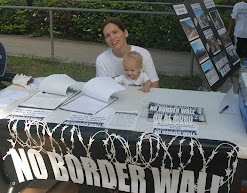
Please join with some of Austin's finest bands in supporting the Sierra Club's Borderlands Team on Sunday, March 4, from 4pm - 7pm, at the 29th Street Ballroom (next to Spiderhouse Cafe on the University of Texas campus). Along with live music from Designer Genes and BitterHeaRt Society they will screen the short Sierra Club documentary Wild vs. Wall, which shows the damage dome by border walls in Texas and along the entire U.S.-Mexico border. Admission is free; donations for the Borderlands Team are welcome.
Unchecked by environmental protections, the walls that began in California’s borderlands now extend over 600 miles, inflicting tremendous damage upon many sensitive ecosystems. In Texas the walls that slice through the Lower Rio Grande Valley National Wildlife Refuge have fragmented habitat that is critical for the survival of endangered ocelots. In Arizona the border walls that cross washes and streams in the Organ Pipe Cactus National Monument have caused severe erosion and flooding. Border walls built in New Mexico’s Playas Valley block the movement of one of the last wild herds of bison, whose range straddles the U.S. – Mexico border. And wall construction in California's Otay Mountain Wilderness Area has involved dynamiting steep mountainsides, sending hundreds of thousands of tons of rock into the Tijuana River below.
The Sierra Club's Borderlands Team is working to prevent further walls and greater destruction along both borders. It is trying to head off legislation that would call for hundreds of miles of new border walls, or waive environmental and other laws along both the northern and southern borders. And the Team is pushing for the Department of Homeland Security to mitigate some portion of the damage that their actions have already inflicted.
Please come out to the 29th Street Ballroom on March 4, and show your support for local music and for our borderlands.
Directions: http://www.spiderhousecafe.com/contact/spider-house-cafe.html

